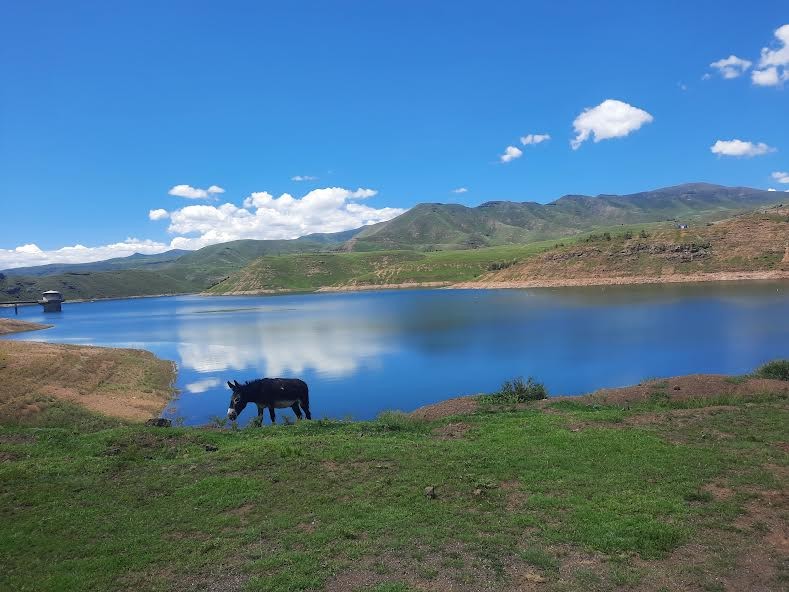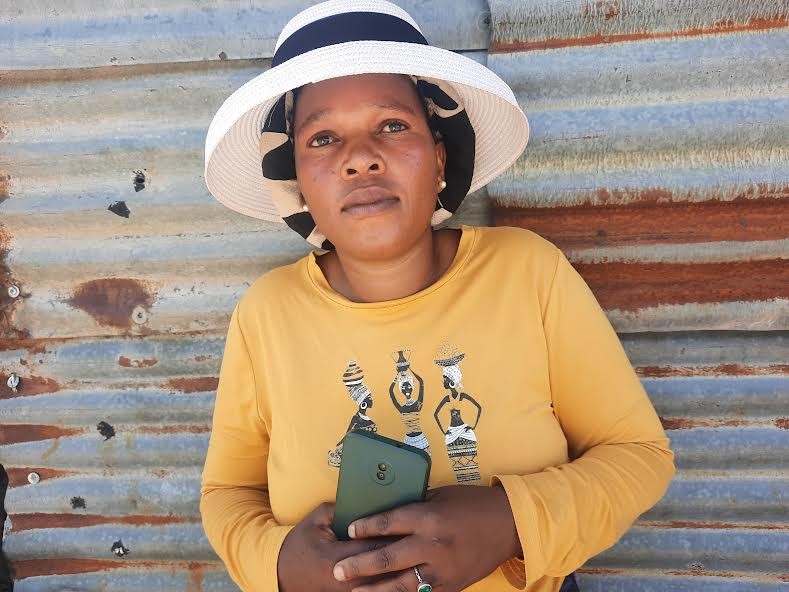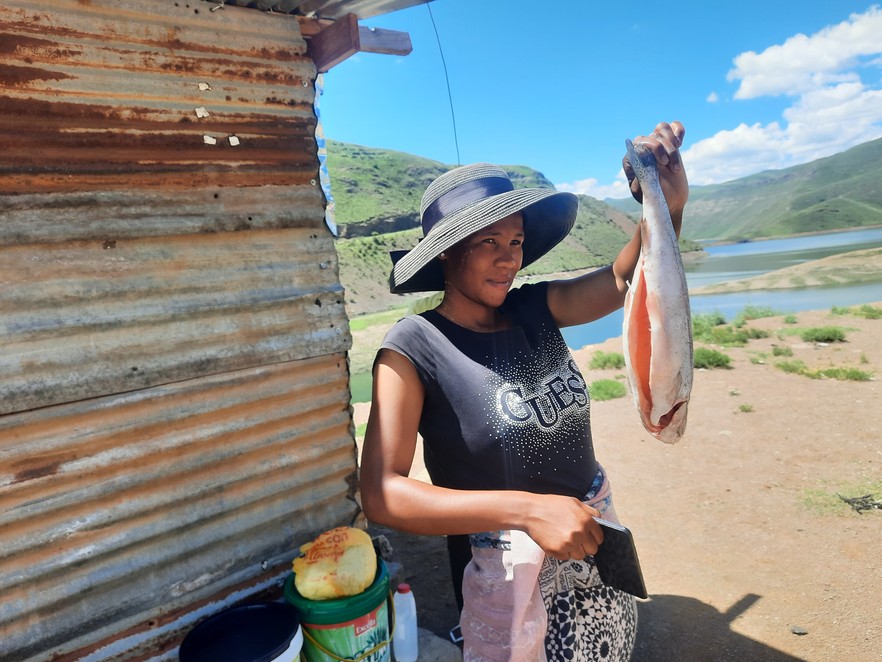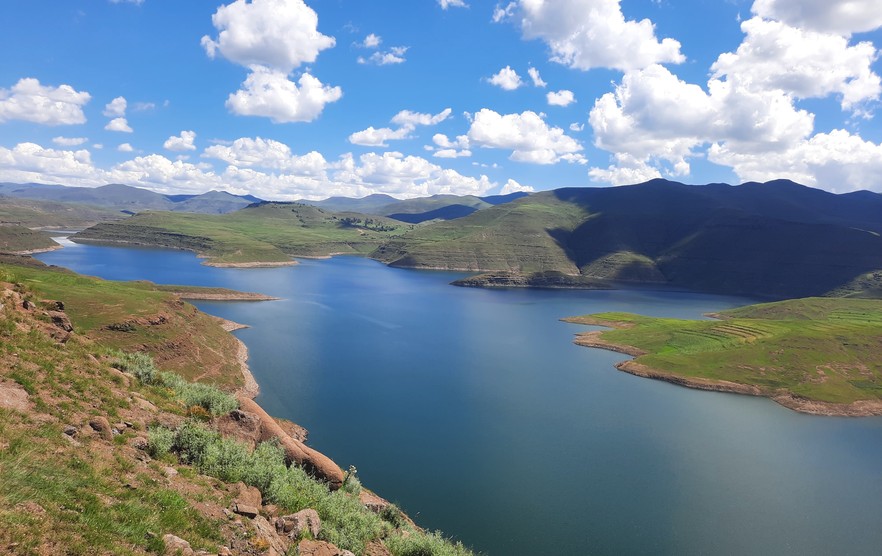Fight over fish in Lesotho’s Katse Dam
Local fishers say they are arrested and beaten up but authorities deny this
Fishing is allowed on Katse Dam but fishers say they have been beaten up by officials. Photos: Sechaba Mokhethi
- Fishers at Katse Dam in Lesotho’s Highlands claim they have been beaten by officials policing the area on behalf of the Lesotho Highlands Development Authority (LHDA).
- The dam is part of the Lesotho Highlands Water Project, through which Lesotho exports water to South Africa.
- It is also the site of a trout farm run by SanLei Premium Trout.
- The LHDA denies any abuse.
Pheello Seafo says he was beaten up by police last year because he was fishing in the Katse Dam in Lesotho’s Highlands.
Seafo, a fisher from Likheleng village in the Ha Lejone area, says a vehicle from the Lesotho Highlands Development Authority (LHDA) stopped near where he was fishing with four others. Police officers came out of the car and asked the men what they were doing.
“We responded that we were fishing. They asked what we were using, and we said hooks. They told us they would torture us if they found nets with us.”
“They mistook one of the lines for a net, began beating us with sticks, and left us there,” he said.
Katse Dam was built as part of Phase One of the Lesotho Highlands Water Project, through which Lesotho exports water to South Africa, earning M3.5-billion (R3.5-billion) annually in royalties. But the local fishers, who have traditionally caught yellow fish and trout to sell to passersby, say they are battling to survive.
‘Mathabo Thibeli’s case is one of the few that ever came to court. A few years ago, Thibeli says, she was arrested by armed soldiers in a boat. With guns pointed at her, she was accused of stealing from the government. “They ordered me to leave the net. The soldiers used their guns to assault me,” she said. “The net was heavy as I had caught so much fish. They beat me with sticks and gun butts on my back while I pleaded that I was just trying to support my family.”
She and another villager were kept in a police cell for three days. “We were charged and fined M100 each, which we paid, and we were freed.”
In other cases, fishermen say they are beaten, their fish are confiscated and then they are sent home.
Mathabo Thibeli says she was arrested and beaten by soldiers.
Restrictive fishing laws
Molise Mare, a community councillor from Likheleng village, grew up fishing in the Malibamatšo River, now submerged under Katse Dam. He remembers that at first the dam’s construction improved their lives. “With the new road infrastructure, urban buyers came for our fish. We raised prices, made profits, and people built houses,” he told GroundUp.
But the prosperity was short-lived. “Everything changed when the LHDA imposed restrictive fishing laws,” Mare said. “We were told we could only catch two fish a day. That was a blow for us because fishing was our livelihood.”
Refiloe Ntsohi, the LHDA Senior Officer responsible for Biodiversity, said the Lesotho Highlands Water Project (Reservoirs) Fishing Regulations govern fishing at Katse Dam. The regulations, based on national fishing laws, prohibit commercial fishing, impose daily catch limits, and regulate fishing tools. “The regulations allow only four fish per household per day,” she said.
The daily quota was intended to ensure households had enough to feed their families, she said. But due to growing demand for fish in Lesotho, some villagers have begun selling their catch outside the dam’s catchment area and some are now using fishing nets to catch large quantities of fish. “Those with resources use nets to catch more, threatening the fish population. This also denies others who can’t afford nets the opportunity for sustainable subsistence fishing,” said Ntsohi.
She said there are rumours that some Chinese buyers are supplying nets to local fishers to increase their haul. “With unregulated net use, even the most productive fish groups are being caught. This puts the entire fish population at risk of extinction,” Ntsohi said.
Fishers prepare their catch.
LHDA Environment Manager Palesa Monongoaha denied any abuse by soldiers or police. Fish patrols were conducted by boat to identify and confiscate illegal nets, she said, accompanied by security forces, she said.
Monongoaha said women officers on patrols sometimes encountered hostility from men. Stones had been used to block the road one woman officer was using. “Since then, we’ve requested backup from security forces during patrols,” she said.
“We use whichever is available at the time, either police or soldiers. But we have never received any reports of human rights violations or torture.”
She said all patrols are documented, and no reports have ever mentioned gunshots or abuse. “Most of the time, we use boats and do not chase after people who run away. We also do not use vehicles for patrols,” she said.
“If anyone had been tortured by soldiers, it would have been reported. I say that with confidence,” Monongoaha added, suggesting that some of the complaints may come from people whose net-fishing operations have been disrupted. “It is simply not true that they were tortured,” she insisted.
“Only two soldiers accompany patrols,” she said. “It’s not like there’s a heavily armed troop. It now appears as if we have a bad relationship with the fishers, but that is not the case. We hold regular meetings and training sessions on subsistence fishing.”
Monongoaha acknowledged that there had been court cases involving illegal fishing, where fish were handed to the police as evidence. However, she said court rulings had not been effective, so the LHDA had stopped pursuing legal action.
Obtaining permits to fish is costly and difficult, the local fishers say.
Pheello Seafo of Likheleng said a return trip from Malibamatšo to Katse at the LHDA offices for a permit costs M120. He said a two-week licence is M100, while a month’s licence costs M200. “It’s hard to afford these fees when we are prohibited from selling fish and have no other jobs,” Seafo said.
The harsh terms push villagers into illegal fishing, or force them to give up fishing altogether.
Thibeli had a permit, but she says she was beaten and arrested for exceeding the daily limit with a net. “We need to sell fish to survive, and nets help us catch more,” she said.
Matsekuoa Thibeli sells fish to passers-by beside the dam.
In 2019, Tomosolo Thibeli says, he survived multiple assaults and gunfire incidents while fishing. “One morning, when an LHDA vehicle appeared, we had to run and hide,” he told GroundUp. “Shots were fired, but we ran for our lives.”
A few days later, Thibeli says, soldiers and police captured him and two boys from his village while they were fishing again. “They forced us to crawl on our knees up and down the hill, beating us as we crawled over sharp stones,” he said. “My knees have never been the same. The pain worsens in winter.”
The two others have given up fishing, but Tomosolo Thibeli refuses to do so. “I won’t leave my home or resort to stealing while my village has these resources,” he said. “I will die fishing in this dam.”
‘Matsekuoa Thibeli says she has been fishing since 2018 and could make up to M1,500 in a day. “One time the police came. We ran away, leaving our fish by the road. They took the fish with our containers and left.”
Villagers also accuse LHDA employees and police of seizing their fish only to keep it for themselves. Confiscations reportedly spike before major weekends and holidays as the police and LHDA employees go home.
Responding to allegations that LHDA staff had confiscated fish for personal consumption last year, Ntsohi said there had been no patrols in the area last year. “So, it can’t be true if people claim this happened last year.”
Scramble for fish bones
The struggle for access to fish has driven villagers to fight over fish bones and fish heads discarded by SanLei Premium Trout, a commercial fish farming company at Katse Dam. These remnants have become a vital protein source for many.
SanLei chief executive Dewald Fourie told GroundUp that the company had provided over 880,000 “high-protein fish heads to the surrounding communities” worth M434,000 in 2024.
But the handouts from SanLei have led to violence. In 2023, a fight over fish heads turned brutal when a villager was stabbed.
“There’s never enough for everyone,” said Malieketso Ramokoatsi, a village committee member. “People grab as much as they can without considering others who are more vulnerable.”
“There was an unfortunate incident in 2023 when some villagers fought among themselves for a share of the fish heads and bones. It was so bad that one of them got his belly cut open with intestines left out,” said Ramokoatsi.
SanLei’s compliance officer, Relebohile Ntoi, confirmed the violent incidents. “One of our drivers distributing fish heads was even threatened with a gun when trying to organise orderly distribution of fish heads and bones at Khohlo-Ntšo … There were fights everyday with some having not got anything while others filled over ten buckets,” Ntoi said.
As part of their licence requirement to farm in Katse Dam, Ntoi said the LHDA required them to submit a community benefit strategy and, “in that strategy, we included fish heads distribution”. She said instead of throwing away the fish heads, “we decided it would be a good source of protein for the community in this catchment for people who can’t afford protein”.
Initially distributed daily at the SanLei plant, the fish heads were later delivered to villages on a rotating schedule as Ntoi says the crowds of villagers who came for the fish were disrupting SanLei’s operations. To avoid further fights in the villages, the fish heads are delivered to schools.
Monongoaha confirmed that the distribution of fish heads is part of SanLei’s community strategy. “Nutritionists say the fish head is the most nutritious part, so instead of throwing them away, we said they should be distributed to combat malnutrition in the catchment,” she said.
She said SanLei attaches a monetary value to the fish heads in their reports on community benefits. “As the only company in Lesotho doing primary fish processing, they produce many fish heads—more than the market can absorb,” she said.
The Lesotho Highlands Development Authority says it monitors the fish population in the dam.
Asked whether LHDA was concerned that communities were not receiving whole fish, Monongoaha said, “Let’s put it this way: SanLei is a business and their sole purpose is to make profit,” she said, saying expecting SanLei to give out whole fish would be like “asking a hotel owner to feed the community for free on certain days”.
Responding to complaints that local people can no longer fish freely as they did before the dam’s construction, while foreign companies profit, Monongoaha said, “These companies do not harvest naturally occurring fish from the dam. They import eggs, hatch them, and keep the fish in cages. If there is any restriction on traditional fishing, it is not related to the companies. In fact, the dam has created a favourable environment for fish to multiply.”
Monongoaha said the LHDA monitored the fish population in Katse and Mohale dams. “We’ve been collecting data for over 14 years now. The aim is to attract investors who can partner with local communities to fish sustainably, so that the fish can be sold and benefit the local people,” she said.
But villagers like Litaba Khanare are not convinced. “Foreign businesses benefit from our waters, while we are left with nothing,” he said. “If our government cared, it would support community-run fish projects to benefit us directly.”
Support independent journalism
Donate using Payfast

Don't miss out on the latest news
We respect your privacy, and promise we won't spam you.
© 2025 GroundUp. This article is licensed under a Creative Commons Attribution-NoDerivatives 4.0 International License.
You may republish this article, so long as you credit the authors and GroundUp, and do not change the text. Please include a link back to the original article.
We put an invisible pixel in the article so that we can count traffic to republishers. All analytics tools are solely on our servers. We do not give our logs to any third party. Logs are deleted after two weeks. We do not use any IP address identifying information except to count regional traffic. We are solely interested in counting hits, not tracking users. If you republish, please do not delete the invisible pixel.





